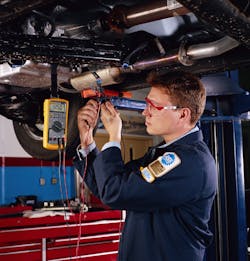Today’s vehicles rely on a combination of electrical and mechanical operations in order to function properly. As computer and electrical components in vehicles have increased, the amount of wiring has grown, providing the potential for more electrical issues to occur within the vehicle. Digital multimeters (DMMs) are the primary tool for diagnosing and finding those problems.
“Whether it’s a broken wire, a blown fuse, bad switch, circuit breaker, resistor, coil or even a battery, learning to test these components of the vehicle is not too difficult and all can be tested/verified using a multimeter,” explains Steve White, president of Electronic Specialties. “It is really an indispensable tool and can save a great deal of time in pinpointing the electrical problem.”
“Being able to measure the basic parameters of an electrical circuit – like volts, ohms and amps – is vital to performing accurate troubleshooting when things go wrong,” adds David Barden, onsite master technician at Power Probe. “Like a doctor needs a stethoscope, a good digital multimeter is probably the single most important tool a technician needs to effectively diagnose electrical circuits.”
A present-day staple in toolboxes, multimeters have replaced some outdated single-use tools like voltmeters and ohmmeters. Basic multimeters measure voltage, current and resistance, while more elaborate multimeters have features that can check things such as frequency, duty cycle, pulse width, complete diode tests and even measure temperatures.
“Now that computers and their sensors are a part of everyday automobile troubleshooting, you need a true multimeter to do the job,” say Fluke Corporation officials.
Because computer technology continues to control more electrical functions on vehicles, technicians need to be able to test a wide variety of signals. Some technicians only need the ability to perform simple electrical measurements, while others may require additional functions from their multimeter.
“DC volts, AC volts, ohms and amps are the most important basic electrical measurements needed for effective testing, but frequency functions like hertz or duty cycle percentage are also needed as those types of readings are becoming more common for things like wheel sensors, MAF sensors, PWM controls, etc.,” says Barden.
What’s more, inductive clamps are now built in to many multimeters, which simplifies current testing because amp measurements can be obtained without breaking into the circuit or wiring a meter in series. This eliminates the possibility of blowing the meter fuses.
Self-calibration functions also have developed recently because some industries require annual re-calibration of all measuring equipment.
“While this function does not substitute for official NISC lab calibration, it can maintain the instrument’s accuracy over a longer time frame than DMMs without this,” says Electronic Specialties’ White.
He adds that multimeters with removable displays or Bluetooth and Wi-Fi connectivity have improved portability.
The industry also has a growing awareness for the specific needs of hybrid electric vehicles. Because many of these vehicles are coming off warranty and making their way to independent garages, technicians must be cognizant of the potential for dangerous high-voltage situations.
“For that reason, shops are specifically seeking out high-grade professional multimeters that are equipped to service the voltage of hybrid cars in order to meet the increased demand,” says Marc Stein, senior product manager at OTC.
What do your the techs need?
There are a number of questions mobile tool dealers can ask to determine what multimeter is right for specific a technician.
Determine the tech’s need for:
- Test abilities – What test functions are available, and which functions does the tech need?
- Accuracy – Multimeters need to be able to produce accurate, reliable, repeatable readings. Accuracy often ranges from 1 percent down to 0.2 percent or lower, and the amount of accuracy needed depends on the services performed by the tech. These accuracy specs can often be found in the manufacturer’s instruction manual.
- Durability – If a tech is concerned about the multimeter’s ability to handle rugged shop conditions, steer that person toward a meter that is drop tested, and has an IP rating.
- Time savings – If a techs are seeking a tool to speed up electrical diagnosis, tell them about features such as auto-ranging, min/max capture, data hold, etc.
Although auto-ranging does not require the user to select the testing range, and therefor saves time, Electronic Specialties’ White says there are advantages to a manual DMM. He says manual ranging DMMs make a technician think before testing, which may help that person learn more about the electrical diagnostic process.
Additional questions to determine a technician’s need and interest for a multimeter include:
- What type of vehicles/equipment do you typically work on?
- What types of problems do you commonly encounter and need to test?
- What type of multimeter do other techs use while performing similar repairs?
- What environment will the meter be used in?
Encourage a customer to take the DMM out of the box, so they can experience how it feels in their hand. Have them inspect the test leads and promote any product training that comes with the tool.
A multimeter’s voltage and class of safety rating also are vital factors for technicians. There are four different safety ratings, referred to as CAT ratings. They are CAT I, CAT II, CAT III and CAT IV. CAT ratings are electrical safety ratings that define the category of safe usage for the electrical tester and what types of circuits they can be safely connected to.
“The higher the CAT rating, the greater impulse voltage the meter can withstand without causing damage or injury from arc flashes,” explains Power Probe’s Barden. “Anyone working around higher voltages or electrical circuits – or circuits that are ultimately connected to power lines – should have a higher safety rated CAT III or CAT IV meter.”
“The quality of safety rating is a major consideration, and will dictate whether a tech is shopping for a higher safety rating, selecting a top-end multimeter at 1,000V or a mid-grade multimeter at 600V, etc.,” adds OTC’s Stein. “Distributors should be knowledgeable of what type of components technicians are working with, and what they will be measuring when testing a vehicle.”
As with other tools, available warranty support for a multimeter can sway a technician’s purchasing decision too.
Because of the range of multimeters available, it is vital to focus on the tasks performed by each individual technician.
“It’s best to choose one that has the tests and features you need for the type of work you do,” says Barden. “For example, a meter with more display digits and higher accuracy may be more important for an electronics technician who works mostly on bench components versus a line electrician who may want features like higher voltage safety rating, a back-lit display or a tougher case.
“For an automotive technician, it is usually somewhere in between.”
Although the range of electrical instruments can be daunting, White says distributors should not shy away from the product category.
“If your customer puts that tool to good use,” he says, “they’ll be a great prospect for a specialty test lead kit down the road.”


